
One of
the most fanciful designs on the
canton of an American flag is known
as the medallion pattern.
Medallions typically consist of
circular wreaths of stars that
typically surround a central star.
Often times, medallion patterns also
contain corner stars as well.
The central star is frequently
larger than the rest of the stars,
and is usually considered to
represent the state whose statehood
is represented by the star count on
the flag. The corner stars may
also be larger in size. The
wreaths of stars may be concentric
and well aligned, or in some cases
somewhat random. Sometimes the
wreaths are circular, and sometimes
they are oval. In general,
medallion patterns are highly valued
by collectors because of their
beauty and relative scarcity.
Medallion patterns became popular
during the Civil War period, though
some printed parade flags with star
counts of 31 or 32 in the medallion
pattern are known. They were
especially popular during the
Centennial in 1876, but by the time
the star count reached 45, medallion
patterns all but disappeared, and
were replaced by the row patterns
that we are most familiar with on
our flags today.
Medallion patterns are found on both
sewn flags and on printed parade
flags. Below are some examples
of medallion variations found on the
stars and stripes.
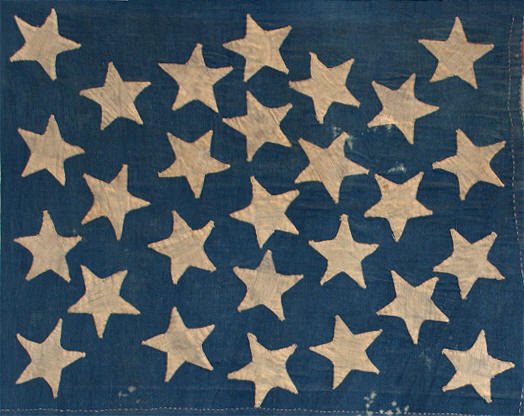 |
27 Stars, 1845-1846.
This flag of 27 stars,
entirely hand sewn and made
of cotton, features an
elliptical medallion with 8
stars in the inner wreath,
14 stars in the outer
wreath, and one star in each
corner. Flags with 27
stars are exceptionally
rare. They were
official for only one year,
1845-1846, and represent
Florida statehood.
|
 |
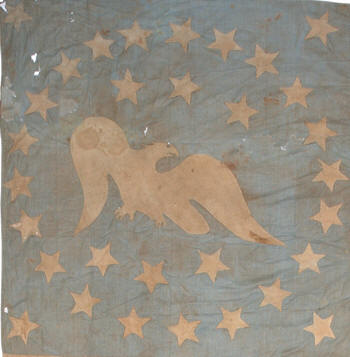 |
31 Stars, 1850-1858.
This beautiful medallion
pattern features four corner
stars and a ring of 25 stars
surrounding a central eagle
and two arches of 3 stars,
one above the eagle and one
below. Flags with eagles in
their cantons are
exceedingly rare, and this
pre-Civil War example of 31
stars represents California
statehood.
|
 |
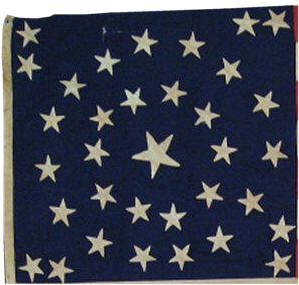 |
34 Stars, 1861-1863.
This spectacular Civil War
flag features an inner
wreath of 10 stars, an outer
wreath of 15 stars, and 2
stars in each corner.
The whimsical placement of
the two stars in altering
directions gives the flag a
beautiful pinwheel effect
and gives a strong sense of
motion.
|
 |
 |
34 Stars, 1861-1863.
This silk Civil War flag is
most likely a Union company
presentation battle flag,
though its specific unit
history is still being
researched. The
beautiful hand sewn stars
are arranged in a double
medallion surrounding a
large center star with three
stars in each corner,
forming a parenthetical
frame around the medallion.
Even fading to the blue on
both sides and wear on the
fly end of the flag
indicates that the flag was
flown outdoors for some
period of time. |
 |
 |
35 Stars, 1863-1865.
This Civil War era homemade
flag, with 35 stars,
features a unique pattern of
stars. The large
center star and four large
corner stars anchor the
canton. A wreath of
seven stars surrounds the
center star. Two arcs
of four stars each bracket
the center wreath.
Between the corner stars are
3 and 3 (top and bottom) and
4 and 4 (left and right).
Flags of 35 stars represent
West Virginia statehood,
when West Virginia seceded
from Virginia during the
Civil War.
|
 |
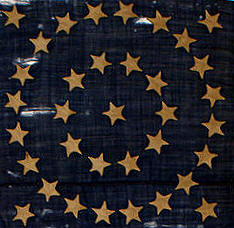 |
35 Stars, 1863-1865.
This Civil War era flag was
made in Baltimore by Jabez
W. Loane. Its
beautiful double medallion
is characterized by
carefully aligned stars in
the wreaths, where the maker
took great care to ensure
that the "head" of each star
was precisely pointed toward
the center, leaving the two
"arms" of the stars to align
with each other into a well
formed circle. This
trait strongly supports an
attribution of the flag to
Loane, joining a rare
handful of flags of a the
same size, star count and
design that have survived. |
 |
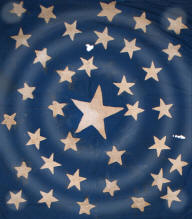 |
36 Stars, 1865-1867.
This post-Civil War flag was
sewn by Mrs. Emma McNutts
for the election of
President Grant.
Although it's debatable
whether or not the pattern
is truly a medallion, due to
the randomness of the stars,
hidden within the flag
is a rare triple medallion with
an inner wreath of 6, an
outer wreath of 12, a third
outer wreath of 12, and
a star in each corner.
|
 |
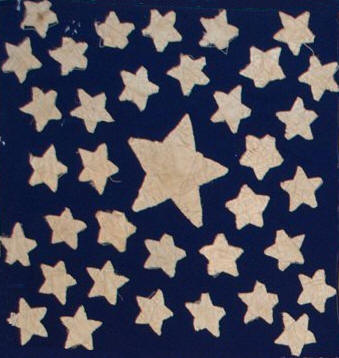 |
36 Stars, 1865-1867.
This fanciful medallion of
36 stars, with is big, bold
center star and whimsical
puffy rings, was made during
the Civil War, and has
specific provenance to the
family in Lancaster,
Pennsylvania who made it.
A note accompanying the flag
reads:
"During the Civil War
when Lancaster, Pa. was in
danger of the Southern army
marching into Lancaster via
York, (before Gettysburg),
Anna Louise Kurtz
Baumgardner (Mother's
mother) got her young
daughters (Mother + Aunt
Anna Cross) and their
friends to make this flag
out of materials she had--to
keep the girls busy and less
frightened." "The
flagpole is in the laundry." |
 |
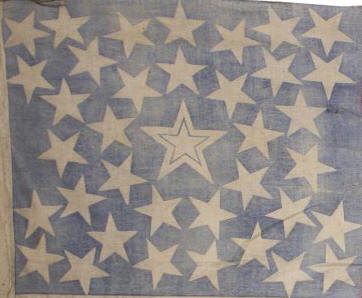 |
37 Stars, 1867-1877.
A beautiful 37 star
medallion flag with a haloed
central star and three stars
in each corner. The
canton has faded to a dusty
blue, and is a striking
color, in contrast with the
still bright red stripes.
The stripes are treadle
stitched and the canton,
which is clamp dyed, is sewn
into the flag.
|
 |
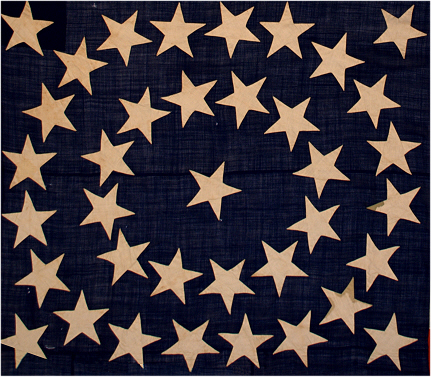 |
37 Stars, 1867-1877.
This spectacular 37 star
medallion flag features two
bold slightly oval rings of
stars. One of the most
striking attributes of the
medallion is the way that
the stars are nested and
packed tightly in the oval
wreaths. The flag
dates to the period of
Reconstruction following the
end of the Civil War, and
most likely was produced for
the American Centennial in
1876.
|
 |
 |
37 Stars, 1867-1877.
An extremely rare pattern
for a sewn flag, this 37
star flag combines the
medallion pattern style,
with a large wreath and four
corner stars, with the
"grand luminary" or "great
star" pattern on a single
flag. It is the only
sewn flag that I'm aware of
that so clearly combines
these two great styles of
early American flags. |
 |
 |
38 Stars, 1876-1890.
This Centennial era
medallion of 38 stars
features a large center
star, two oval medallions,
and two radiating stars in
each corner of the canton.
The outer wreath of
seventeen stars surrounds
the inner thirteen stars,
which represent the original
thirteen colonies. |
 |
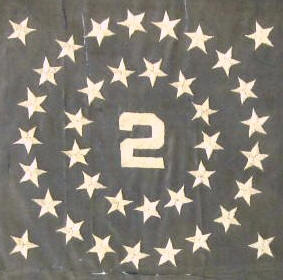 |
38 Stars, 1876-1890.
This is an official U.S.
Army Flank Marker of 38
stars, originally belonging
to the U.S. 2nd Infantry
Regiment. The
beautiful double medallion
is made of hand embroidered
stars on silk, of the finest
quality workmanship.
The large embroidered 2
regimental unit designation
is also embroidered.
These flags are extremely
rare. Only a few of
these fragile silk flank
markers survived their use
in the field. The flag
most likely saw service in
the Oregon and Idaho
Territories, and in Nebraska
and the western plains. |
 |
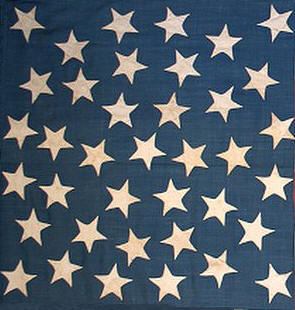 |
38 Stars, 1876-1890.
This beautiful sewn flag
features a rare triple
medallion in which all stars
are the same size. The
center star is surrounded by
a wreath of 6 stars,
followed by a wreath of 11
stars, and an outer wreath
of 16 stars, with four
corner stars. A
masterpiece of Centennial
Era flag making. |
 |
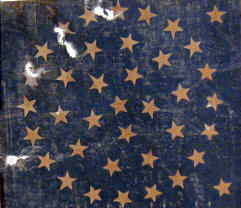 |
38 Stars, 1876-1890.
This printed parade flag of
38 stars in the medallion
pattern is one of the
largest of its kind, at more
than 50 inches in length.
38 star flags in this style
with two outliers in the top
right and bottom right
corners, were made in
various sizes, most
typically in small
hand-waving size. They
were popular during the
Centennial in 1876, in
anticipation of Colorado
statehood, granted on August
1, 1876. |
 |
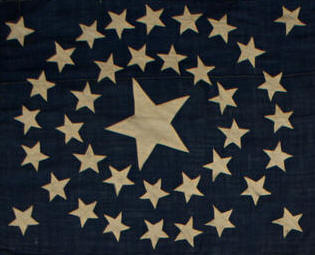 |
38 Stars, 1876-1890.
This medallion pattern from
the Centennial Era features
a very rare double oval
wreath of stars surrounding
a spectacular large center
star along with four corner
stars. The inner
wreath of stars numbers 13,
representing the original 13
colonies, and the large
center star represents
Colorado. This
particular flag descended
through the family of
William "Buffalo Bill"
Cody's youngest sister, Mrs.
May Cody Decker. |
 |
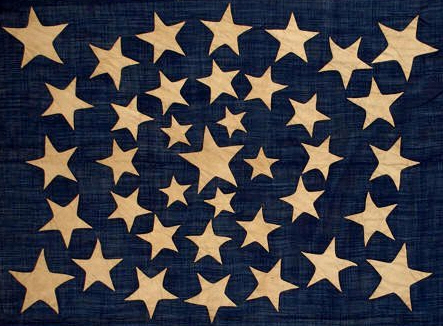 |
38 Stars, 1876-1890.
This gorgeous oval medallion
features an extremely rare
combination of four sizes of
stars. The central
star and four corner stars
are the same size, with
three progressively smaller
sizes of stars arranged in
wreaths around the center.
The flag, which is entirely
hand sewn, is a masterpiece
of Centennial Era American
Flag making. |
 |
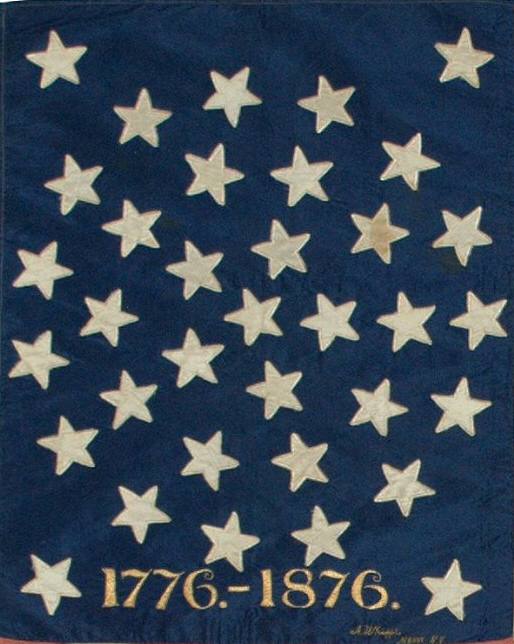 |
38 Stars, 1876-1890.
Another masterpiece flag
from the American
Centennial, this flag
consists of a medallion of
38 silk stars on a silk
canton. Five spokes
radiate from the center
star, and three stars sit in
each wedge between the
spokes. The dates
"1776-1876", clear evidence
that the flag was made to
celebrate the American
Centennial, are beautifully
hand embroidered in gold
thread, along with the name
and home town of the maker,
"A. Whipple, Albany NY". |
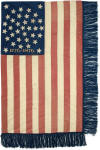 |
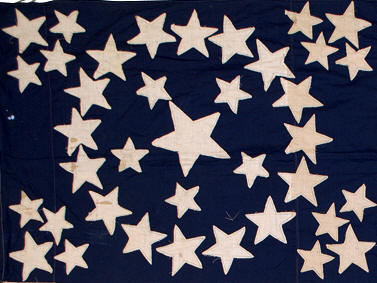 |
38 Stars, 1876-1890.
This rare medallion, also
from the period of the
American Centennial, was
made in Fairfield County,
Ohio. The flag is made
of cotton fabric,
stitched with a treadle
machine. The flag's
medallion exhibits several
exceptionally rare traits,
such as the presence of four
corner stars, variable sized
stars and a large center
star. It descended in
the family of Willabe Boyer
who settled his farm near
Canal Winchester, Ohio in
the mid 1800's. |
 |
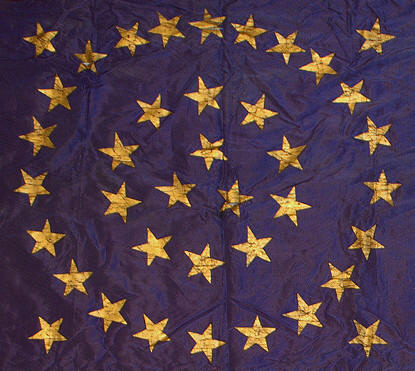 |
39 Stars, 1875.
The 39 star count is
considered unofficial, and
only a very small number of
39 star flags of pieced and
sewn construction are known
to exist. Of those,
only a handful, perhaps less
than five, have a star
pattern other than straight
rows of stars. This
rare medallion of gilt stars
on silk is the only
medallion I'm aware of that
has three center stars.
It is one of the rarest and
most beautiful among known
examples of the 39 star
count. |
 |
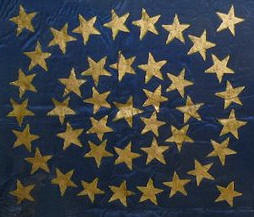 |
42 Stars, 1889,
Unofficial. This
beautiful military-grade
flag with a double oval
medallion pattern originally
started as a 38 star flag,
to which four center stars
were added. Most
likely, the flag was made by
a contracted manufacturer to
provide flags to military units.
When four states entered the
Union in 1889, the flag
maker updated this flag,
prior to selling it.
Difference in highlighting
on the edges of the
four center stars and
slightly brighter gilt, compared to the other 38
stars, is clear
evidence of this. |
 |
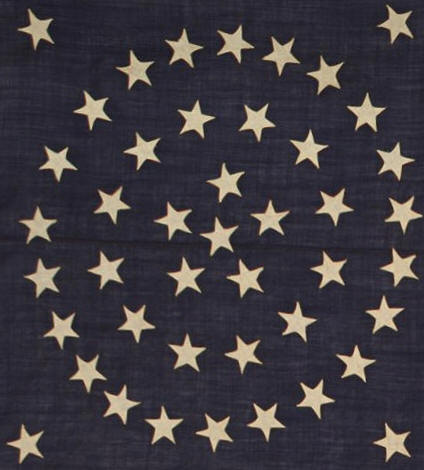 |
44 Stars, 1891.
This rare later period
triple medallion flag is in
extraordinary condition and
form. With the
exception of one missing tie
at the top left corner of
the flag, it is completely
intact, with all of its
original golden fringe and
virtually no signs of aging.
The presence of the silk
ties and the gold fringe are
evidence that the flag,
which was professionally
manufactured, was most
likely made for military or
official use. The flag
represents Wyoming statehood
which took affect on July
10, 1890, and became
official for a period of 5
years from July 4, 1891 to
July 4, 1895. |
 |
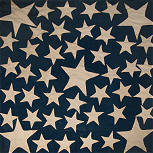 |
44 Stars, 1891.
This wonderful medallion is
in a rare "wreath in a
square" pattern. The
stars of the flag take up
nearly the entire canton,
and four large corner stars
anchor a square formation of
stars. The outer square
encloses two inner circular
wreaths of stars, which in
turn surround a large center
star. This exuberant
late period medallion flag
is made entirely of cotton
with hand sewn stars, and is
likely a homemade example. |
 |
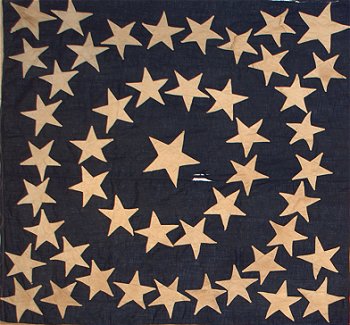 |
48 Stars, 1912.
Only one of two flags, along
with IAS-00002 below, that I
am aware of with a medallion
pattern in the 48 star
count. This beautiful
medallion features a large
center star and four large
corner stars, each of which
is flanked by two smaller
stars. It is one of
the few examples of the
medallion pattern with three
corner stars. Note how
the stars are nestled
together and rotated and
fitted to form nearly solid
rings of stars. A
beautiful and exuberant
homemade example. |
 |
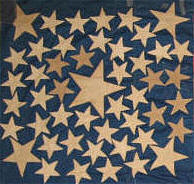 |
48 Stars, 1912.
One of the last of the great
medallions flags.
Flags such as this fell out
of use following President
Taft's
Executive Order of 1912
which stipulated that stars
would henceforth be
displayed in rows.
This flag is one of the
latest medallion flags
known, and ranks among the
most spectacular among all
medallion flags from any
period. Click
here to read more about
this flag. |
 |
|
 |
Next:
Writing on Flags |
 |
|
|

